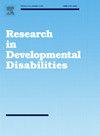Assessing the impact of Transcranial Direct Current Stimulation (tDCS) over the dorsolateral prefrontal cortex on social communication in children and adolescents with Autism Spectrum Disorder (ASD)
IF 2.6
2区 医学
Q1 EDUCATION, SPECIAL
引用次数: 0
Abstract
Introduction
Autism Spectrum Disorder (ASD) is characterized by persistent difficulties in social communication and behavior regulation. Although behavioral and pharmacological interventions exist, many yield limited improvements in these core areas. Transcranial Direct Current Stimulation (tDCS), a non-invasive neuromodulation technique, has shown potential for enhancing social and cognitive functions in individuals with ASD. This study evaluated the impact of tDCS, applied over the Dorsolateral Prefrontal Cortex (DLPFC), on social communication and behavioral outcomes in children and adolescents with ASD.
Materials and methods
Two hundred sixty-five participants (3–18 years) with clinically confirmed ASD diagnoses (including ADOS-2 assessments) received a four-week course of tDCS over the DLPFC. Outcome measures included the Social Responsiveness Scale (SRS-2), the Autism Diagnostic Observation Schedule (ADOS-2), and the Aberrant Behavior Checklist (ABC). Family perceptions were explored through semi-structured interviews. Quantitative data were analyzed using paired t-tests and ANOVA, and qualitative data were examined via thematic analysis. No sham or control group was included.
Results
Participants exhibited significant improvements in verbal and non-verbal communication (e.g., vocabulary, eye contact, gesture use), as well as reductions in repetitive behaviors and emotional dysregulation. Families reported decreased parental stress and enhanced family interactions, underscoring the intervention’s feasibility and acceptability.
Conclusion
tDCS over the DLPFC shows promise as an adjunctive intervention to improve social communication and behavioral outcomes in children and adolescents with ASD. However, the absence of a control group and the short duration of follow-up limit causal inferences. Further randomized, controlled, and longitudinal studies are needed to confirm these preliminary findings and determine their long-term clinical relevance.
评估经颅直流电刺激(tDCS)对自闭症谱系障碍(ASD)儿童和青少年社交交流的影响
自闭症谱系障碍(autism Spectrum Disorder, ASD)以持续的社会沟通和行为调节困难为特征。虽然存在行为和药理学干预措施,但许多措施在这些核心领域的改善有限。经颅直流电刺激(tDCS)是一种非侵入性神经调节技术,已显示出增强ASD患者社交和认知功能的潜力。本研究评估了在背外侧前额叶皮层(DLPFC)上应用tDCS对儿童和青少年ASD的社会沟通和行为结果的影响。材料与方法265名临床确诊ASD(包括ADOS-2评估)的参与者(3-18岁)在DLPFC上接受了为期四周的tDCS疗程。结果测量包括社会反应性量表(SRS-2)、自闭症诊断观察量表(ADOS-2)和异常行为检查表(ABC)。通过半结构化访谈探讨家庭观念。定量资料采用配对t检验和方差分析,定性资料采用专题分析。不包括假手术组或对照组。结果参与者在语言和非语言交流(如词汇量、眼神交流、手势使用)方面表现出显著改善,重复行为和情绪失调也有所减少。家庭报告父母压力减少,家庭互动增强,强调了干预的可行性和可接受性。结论dcs对DLPFC的辅助干预有望改善儿童和青少年ASD的社会沟通和行为结果。然而,缺乏对照组和随访时间短限制了因果推论。需要进一步的随机、对照和纵向研究来证实这些初步发现并确定其长期临床相关性。
本文章由计算机程序翻译,如有差异,请以英文原文为准。
求助全文
约1分钟内获得全文
求助全文
来源期刊

Research in Developmental Disabilities
Multiple-
CiteScore
5.50
自引率
6.50%
发文量
178
期刊介绍:
Research In Developmental Disabilities is aimed at publishing original research of an interdisciplinary nature that has a direct bearing on the remediation of problems associated with developmental disabilities. Manuscripts will be solicited throughout the world. Articles will be primarily empirical studies, although an occasional position paper or review will be accepted. The aim of the journal will be to publish articles on all aspects of research with the developmentally disabled, with any methodologically sound approach being acceptable.
 求助内容:
求助内容: 应助结果提醒方式:
应助结果提醒方式:


